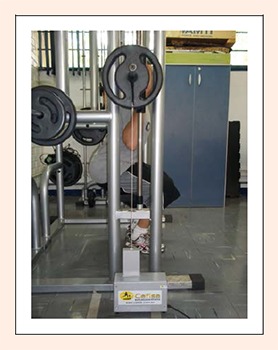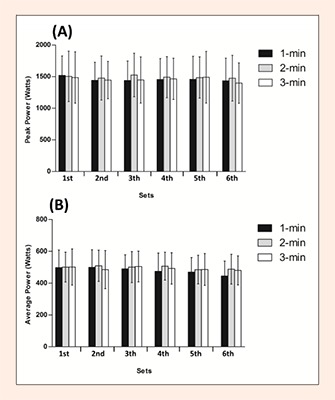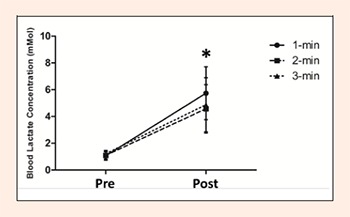Abstract
Studies investigating the effect of rest interval length (RI) between sets on neuromuscular performance and metabolic response during power training are scarce. Therefore, the purpose of this study was to compare maximal power output, muscular activity and blood lactate concentration following 1, 2 or 3 minutes RI between sets during a squat power training protocol. Twelve resistance-trained men (22.7 ± 3.2 years; 1.79 ± 0.08 cm; 81.8 ± 11.3 kg) performed 6 sets of 6 repetitions of squat exercise at 60% of their 1 repetition maximum. Peak and average power were obtained for each repetition and set using a linear position transducer. Muscular activity and blood lactate were measured pre and post-exercise session. There was no significant difference between RI on peak power and average power. However, peak power decreased 5.6%, 1.9%, and 5.9% after 6 sets using 1, 2 and 3 minutes of RI, respectively. Average power also decreased 10.5% (1 min), 2.6% (2 min), and 4.3% (3 min) after 6 sets. Blood lactate increased similarly during the three training sessions (1-min: 5.5 mMol, 2-min: 4.3 mMol, and 3-min: 4.0 mMol) and no significant changes were observed in the muscle activity after multiple sets, independent of RI length (pooled ES for 1-min: 0.47, 2-min: 0.65, and 3-min: 1.39). From a practical point of view, the results suggest that 1 to 2 minute of RI between sets during squat exercise may be sufficient to recover power output in a designed power training protocol. However, if training duration is malleable, we recommend 2 min of RI for optimal recovery and power output maintenance during the subsequent exercise sets.
Key points.
This study demonstrates that 1 minute of RI between sets is sufficient to maintain maximal power output during multiple sets of a power-based exercise when it is composed of few repetitions and the sets are not performed until failure. Therefore, a short RI should be considered when designing training programs for the development of muscular power.
Short RI may be more practical for strength coaches under time constraints (i.e. 1 minute of RI required only 7 minutes to complete an exercise session, while with 2 minutes take 12 minutes, and 17 minutes with 3 minutes of RI).
Future research is needed to examine the longitudinal effects of interval rest in training programs designed for the development of muscular power.
Key words: Power development, muscle recovery, power training, strength training
Introduction
Muscle power is an important factor during athletic performance and daily tasks performed by youth and seniors (ACSM, 2009; Nogueira et al., 2009). Studies reported that muscle power increases after strength training (ST) programs performed with high-velocity (ACSM, 2009). ST is commonly performed with multiple sets of repetitions protocols (ACSM, 2009; Peterson et al., 2005), and the magnitude of strength and maximal power output gains rely on the manipulation of several variables, such as rest interval (RI) between sets (ACSM, 2009; Willardson, 2006), muscle action velocity, training load, and volume (ACSM, 2009; Peterson et al., 2005).
The American College of Sports Medicine (ACSM) position stand recommends that power training should comprise 3 to 6 repetitions per set with a load ranging from 0 to 60% of one repetition maximum (1RM) using high muscle action velocity (ACSM, 2009). The ACSM also recommends rest periods of at least 2 to 3 minutes between sets for core exercises, and 1 to 2 minutes for assistance exercises (ACSM, 2009). However, according to the ACSM there is no strong current scientific evidence to support these RI recommendations. Moreover, this recommendation was based on a consensus of panel members using clinical experience (i.e. evidence D) (ACSM, 2009). In addition, the RI between sets recommendation from the ACSM was also based only on the study of Abdessemed et al. (1999). They investigated the effects of three different RI (1-, 3- or 5 minutes) between sets on power output during bench press exercise. The authors reported a decrease on power output and higher blood lactate only after the 1 minute RI.
Furthermore, Pincivero et al. (1998) compared muscle power output from quadriceps and hamstring during a reciprocal action exercise protocol using short (40 s) and long RI (160 s) during four maximal effort sets on an isokinetic dynamometer. Muscle power production was reduced only with the 40 s RI. The authors reported that shorter RI may not be sufficient to allow power output recovery between sets of resistance exercise. However, these investigations were conducted using single-joint knee extension isokinetic exercise (Pincivero et al., 1997) and bench press exercise (Abdessemed et al., 1999), which may have limited application for lower-body multi-joint isoload exercises. In addition, most athletes that rely on lower-body power (i.e. volleyball, basketball, soccer, American football, and etc.) usually perform squat power training to improve knee extensors power performance.
Therefore, due to the limited amount of scientific evidence on the effect of RI on lower-body power training, the purpose of the present study was to compare maximal power output, muscular activity and blood lactate concentration following 1, 2 or 3 minutes RI between sets during squat training in young resistance-trained men. Our hypotheses was that 2 and 3 minutes RI between sets would allow greater neuromuscular recovery and lower metabolic impact (i.e., lower lactate responses) when compared to 1 minute RI during a multiple-sets squat power training exercise protocol.
Methods
Experimental approach to the problem
A repeated-measures design was used on a nonrandomized convenience sample of younger resistance trained men. Subjects were tested for power output (average and peak), blood lactate concentration, and muscle activity of the vastus medialis, vastus lateralis and rectus femoris during three different testing protocols. The exercise protocol was six sets of six repetitions of squat exercise, and the RI between sets was 1, 2, and 3 minutes. The RI between sets was randomly assigned across the three testing days separated by a minimum of 72 hours. A squat exercise was used because it is often used for training in sports (Gullett et al., 2009).
Subjects
A priori statistical power (1-β) was calculated for each dependent variable using G*Power software (Faul et al., 2007). The following design specifications were taken into account: α = 0.05; (1-β) = 0.8; effect size f = 0.25; test family = F test and statistical test = ANOVA repeated measures, within-within interaction. The sample size estimated according to these specifications was 12 subjects. Therefore, twelve resistance-trained men (age = 22.7 ± 3.2 years; height = 1.79 ± 0.08 m; body mass = 81.8 ± 11.3 kg; 1-RM smith squat = 131.7 ± 26.7 kg) volunteered to participate in this study. Participants were considered “resistance-trained” (at least six months of consistent RT experience) based on the criteria set by the American College of Sports Medicine (Kraemer et al., 2002). In general, the subjects in their habitual training routine practiced noncompetitive resistance exercise for the purpose of muscle hypertrophy. Their training routine included four to six sessions per week, performing six to 12 sets per muscle group, and six to 12 maximum repetitions per set with 60 to 120 s of RI between sets. Subjects were excluded if they had a history of musculoskeletal injuries or any disease that could compromise their health during the study. The investigation was approved by the local institutional review board for use of human subjects, which is in accordance with the Declaration of Helsinki, and all the subjects read and signed an informed consent form before participation. Subjects were asked to maintain their normal hydration status and dietary intake, to avoid any strenuous exercise in the 48 h before the experimental sessions, and avoid smoking, alcohol and caffeine consumption for 24 h before all tests.
Strength assessments
The maximum strength of the lower limbs (1RM) was assessed during the squat exercise using a Smith machine and according to the recommendations of Brown and Weir (2001). A pre-determined range of motion and proper technique were required for each successful 1RM trial. In addition, an elastic band was placed behind the subject to keep the bar displacement and knee angle (~80°) constant on each squat repetition. The position of each subject were recorded and reproduced throughout the study. The testing procedures were performed by the same investigator, and the determination of 1RM load was conducted on two non-consecutive days (test-retest) with a minimum of 72 h between tests. The intraclass correlation coefficient (ICC) was used to determine the test-retest reliability (r = 0.99) (Stratford, 2008). The determination of 1RM enabled the calculation of training loads (60% of 1RM) used during the experimental sessions.
Experimental sessions
An overview of the experimental protocol is presented in Figure 1. The three experimental sessions were conducted after three to seven days following the 1RM determination. Each session consisted of performing the squat exercise with 60% of their pre-determined 1RM (Loturco et al., 2013; Izquierdo et al., 2002). Subjects performed six sets of six repetitions using 1, 2 or 3 minutes RI between sets in a counterbalanced order separated by three to seven days. Subjects were instructed to perform the concentric phase as fast as possible and the eccentric phase with 2 s.
Figure 1.

Experimental design.
Anthropometric assessment
Body weight was assessed with a digital scale to the nearest 0.1 kg (Lider, Sao Paulo, Brazil), and height was assessed with a stadiometer to the nearest 0.1 cm (Sanny, Murrhardt, Germany). Measurements were taken by a certified exercise technologist.
Muscular power output
The power produced during each experimental session was measured by a linear position transducer (Peak Power, Cefise, Sao Paulo, Brazil). The configurations for test assessment and calibration followed the manufacturer’s specifications. The equipment was attached to the barbell to register the time and the displacement at a frequency of 100 Hz (Figure 2). Subsequently, peak and average power (watts) produced during the concentric contraction were determined by the manufacturer software (version 4.0.4.6; Peak Power software analysis).
Figure 2.

Power produced during squat exercise was measured by a linear position transducer attached to the barbell. Subject was instructed to perform the concentric phase as fast as possible.
Electromyographic assessment
Muscle activity was recorded in vastus lateralis (VL), vastus medialis (VM) and rectus femoris (RF) by an electromyograph Miotool 800 with 2000 V/V gain common mode rejection ratio > 110 dB, during two maximal voluntary isometric contractions performed in the Smith machine two minutes before and two minutes after each power test. The isometric efforts lasted 3 s with 1 minute of rest between the trials and the knees bent at 60 degrees during the assessment (Brown and Weir, 2001). Skin asepsis and electrodes placement followed the recommendations of the Surface Electromyography for the Non-Invasive Assessment of Muscles (SENIAM) project (Hermens et al., 2000). After shaving, mild abrasion and alcohol cleaning, Ag/AgCl adhesive electrodes (Meditrace Mini; Tyco Healthcare Group, Mansfield, MA, USA) were positioned on the muscles of interest. The position of the electrodes was marked with a permanent marker to ensure the same placement in all evaluations. The electromyographical (EMG) data were sampled at a frequency of 2,000 Hz and amplified 100 times. The synchronization of EMG and load cell signals performed by the electromyographic interface used a trigger that indicated the beginning and the end of muscle contraction.
Specific routines written in Matlab 6.5 (Mathworks; Natick, MA, USA) were designed for digital signal processing. The EMG signals were filtered by a 4th-order butterworth bandpass filter with a passband between 20 and 500 Hz (Carvalho et al., 2010; Clancy et al.). The EMG data of VL, VM and RF were fullwave rectified and normalized in amplitude by the maximum value of their respective signals registered in the isometric contractions performed in the beginning of the test protocol. After the normalization procedure, the average root mean square (RMS) value of the two isometric contractions performed before and after the power tests were calculated in windows of 5,000 samples (2.5 s) extracted from the central part of the isometric contractions.
Blood lactate concentration
Standard procedures were followed for blood lactate collection, management and analysis (Goodwin et al., 2007). Blood samples (25 µL) were collected from the earlobe during a rest period (before) and after each experimental procedure. Blood lactate concentration was determined by electroenzymatic method (1500 Sport; Yellow Springs Instruments Inc., Yellow Springs, OH, USA).
Statistical analyses
Descriptive statistics (mean values ± SD) were used to summarize the characteristics of the population, lactate, power output and muscle activation data. The Shapiro-Wilk test revealed that all data presented normal distribution. ANOVA 3 (RI) x 6 (sets) repeated measures was applied to verify the main effects and interactions on peak and average power. ANOVA 3 (RI) x 2 (time) repeated measures was applied to muscular activation and blood lactate concentration. When the sphericity was violated the Greenhouse-Geisser procedures was used to correct the degree of liberty and P value. Significance level was set at 5% and version 17.0 of Statistical Package for Social Sciences (SPSS, IBM, Armonk, NY) was used for all analyses. Also, the effect size (the difference between pretest and posttest scores divided by the pretest standard deviation) and the scale proposed by Rhea (2004) were used.
Results
The peak and average power output are presented in Figure 3. Peak power decreased 5.6%, ES: 0.28 (trivial); 1.9%, ES: 0.07 (trivial); and 5.9% ES: 0.22 (trivial) after 6 sets using 1, 2 and 3 minutes of RI, respectively. Average power also decreased 10.5%, ES: 0.47 (small); 2.6%, ES: 0.14 (trivial) and 4.3%, ES: 0.19 (trivial) after 6 sets using 1, 2 and 3 minutes of RI, respectively. There was no main effect of RI length (F(2,22) = 0.935, p = 0.41, 1-β = 0.53; (F(2,22) = 0.970, p = 0.40, 1-β =0.55, respectively), neither main effect of sets on peak and average power output for the different RI lengths (F(5,55)=1.151, p = 0.35, 1-β = 0.83; (F(5,55) = 2.665, p = 0.07, 1-β = 0.99, respectively). In addition, there was no significant interaction between RI and sets on peak and average power output (F(10,110) = 0.440, p = 0.74, 1-β = 0.68; F(10,110) = 1.140, p = 0.35, 1-β = 0.99, respectively).
Figure 3.

(A) Peak power (in watts) in each set; (B) Average power (in watts) in each set; values are mean ± SD.
Mean ± SD and effect sizes (ES) from muscle activation are presented in Table 1. There was no significant difference on muscle activation between RI lengths (p = 0.26-0.69) and time condition (pre/post) in any of the analyzed muscles (p = 0.12-0.34).
Table 1.
Descriptive data and comparisons between of rest interval lengths for muscle activation before and after power exercise session mean (±SD) and [95% confidence interval].
| Muscular Activation | 1-min | 2-min | 3-min | |||
|---|---|---|---|---|---|---|
| Pre | Post | Pre | Post | Pre | Post | |
| Rectus Femoris (mV) | 23.04 (1.42) | 21.57 (5.17) | 22.79 (4.83) | 20.49 (4.83) | 23.32 (2.96) | 18.74 (2.92) |
| [21.55, 24.54] | [16.14, 27.00] | [20.69, 24.90] | [15.41, 25.56] | [20.21, 26.43] | [15.67, 21.81] | |
| Vastus Medialis (mV) | 26.24 (4.84) | 24.43 (3.17) | 25.99 (3.85) | 21.89 (3.61) | 26.18 (1.85) | 20.95 (2.95) |
| [21.17, 31.32] | [21.10, 27.76] | [21.95, 30.03] | [18.10, 25.68] | [24.24, 28.12] | [17.85, 24.05] | |
| Vastus Lateralis (mV) | 20.75 (4.31) | 20.80 (7.49) | 19.86 (3.28) | 19.12 (6.50) | 20.93 (4.60) | 16.21 (3.13) |
| [16.77, 24.74] | [13.87, 27.73] | [16.82, 22.89] | [13.11, 25.13] | [16.67, 25.19] | [13.32, 19.10] | |
The blood lactate concentration was higher post power session F(1,8) = 50.408; p < 0.001, 1-β = 1.00), but there was no significant (p > 0.05) effect of RI length on blood lactate concentration (1-min: 5.6 mMol, 2-min: 4.6 mMol, and 3-min: 4.9 mMol); F(2,16) = 1.403, p = 0.28, 1-β = 0.71) (Figure 4).
Figure 4.

Blood lactate concentration pre and post the power exercise sessions; values are mean ± SD. * Greater than pre-value for all rest interval lengths.
Discussion
The main finding of the present study was that regardless of RI (1-, 2-, and 3-minutes) power output was maintained during squat exercise throughout the exercise session in resistance-trained men. The results are not in accordance to our hypothesis since there was no difference on peak and average power between RI lengths. In addition, blood lactate increased with exercise, but no difference was reported between the three RI. Muscle activities after power exercise sessions were non-significantly affected by RI lengths. Nevertheless, despite of non-significance differences among the rest interval lengths, the choice of rest interval may take in account the lower decrement on average power when 2-min was used (2.6%) compared with (10.5%) using 1-min of rest interval.
These data are in agreement with the findings of previous research that indicates a fast recovery in maximal performance after 1RM tests of bench press (Weir et al., 1994) and squat exercise (Matuszak et al., 2003). Both studies examined the effects of different RI lengths in weight-trained men. The authors indicated that 1 minute RI length is sufficient for recovery between attempted lifts during 1RM testing or training. Despite the clear differences among our experimental protocol and the aforementioned studies, such as load performed and exercise velocity, the data suggest that a short term high intensity exercise bout may be performed with short recovery length when involving strength-trained subjects.
In contrast, Abdessemed et al. (1999) evaluated the effects of RI between sets (1-, 3- and 5-minutes) on power and blood lactate during 10 sets of 6 repetitions of bench press at 70% 1RM in untrained men. Their findings revealed a lower average power (27% decreased) and an increase in blood lactate after 1 minute when compared to 3- and 5-minutes of RI. The discrepancy between the study of Abdessemed et al. (1999) and our results may be, in part, due to the differences in the volume and intensity of the exercise bout, physical background of evaluated subjects, and muscle groups assessed. It is known that the lower limbs have greater endurance characteristics and higher fatigue resistance than upper-limbs (de Salles et al., 2009; Willardson and Burkett, 2006). Furthermore, Abdessemed et al. (1999) used an intensity of 70% 1RM during bench press exercise whereas in our study the intensity was 60% of 1RM for squat exercise.
The training load that results in the greatest maximal mechanical power output (Pmax) has been referred to as the power “optimal” load. Training at the power optimal load results in superior improvements in muscle power output because of specific neuromuscular adaptations (Loturco et al., 2013). The power optimal load varies from exercise to exercise, and may be achieved approximately at 40% of 1 RM in the bench press, and approximately at 60% of 1 RM in the squat exercise (Izquierdo et al., 2002). Thus, considering the exercise specificity, the training load used in the study of Abdessemed et al. (1999) was much higher than Pmax load, which could have negatively affected muscle recovery and consequently limited the exercise performance. It seems reasonable to suggest this effect due to a greater blood lactate concentration reported when 1 minute of RI was used in their study. In another study, Pincivero et al. (1998) evaluated 15 college age volunteers (men and women) without resistance training experience. Each subject performed four sets of 10 concentric knee flexion and extension in an isokinetic dynamometer using a short RI (40 sec) or a long RI (160 sec). Their results showed that average power was reduced only in the group that performed sets using 40 sec of RI. Thus, it seems that very short RI between sets (i.e., below 1 minute) do not allow for muscle power output recovery, and a minimum of 1 minute may be needed in order to maintain performance. In addition, similar results were found by Paulo et al. (2012). They reported that 1 minute produces greater average power when compared to ~30 seconds RI after 6 sets of 6 reps of power training (Paulo et al., 2012). Recently, Hester et al. (2014) submitted resistance-trained men to squat protocol consisting of 5 sets of 16 repetitions at 40% of 1-RM. They showed that despite of maintenance of peak power output across the five sets, a decrement within each set on power output was found. Hence, it seems that when a greater number of repetitions (> 6 reps) are performed a detrimental effect of fatigue became evident.
In the present study, the blood lactate concentration increased significantly from pre to post-exercise condition (from 1.1 to 4.6-5.7 mM) regardless of RI used. However, contrary to our expectations, this increase in the blood lactate concentration was not associated with impaired muscle power output, and the performance was maintained over the whole exercise session. The results suggest that independent of the increase in blood lactate, muscle power performance remained stable. This finding corroborates with a previous investigation reporting that acidosis does not impair muscle excitability, at least up to the level achieved in the present study (Pedersen et al., 2004). In addition, we observed similar blood lactate responses as those reported by Ratamess et al. (2007) who found a similar pattern of increase in blood lactate immediately post-exercise (from 1.8 to 5.5–8.4 mM), without significant differences between different RI lengths (30 s, 1, 2, 3, 5 minutes).
To identify possible neuromuscular mechanisms related to the muscle power performance during the exercise protocols, we assessed the EMG amplitude and, as observed, no significant changes occurred after all power exercise protocols. Regarding the EMG amplitude, studies have often shown increases in these values (Izquierdo et al., 2009; Gorostiaga et al., 2012) at fatigue conditions, whereas decreases (Stephens and Taylor, 1972) and an absence of change (Linnamo et al., 2000; McCaulley et al., 2009) have also been observed. Our results are in accordance with those by Linnamo et al. (2000), who investigated neuromuscular responses to explosive (40% of 1 RM) and heavy (70% of 1 RM) resistance loads. They observed no changes in the EMG amplitude values, whereas only slight increases were observed in the median frequency during the explosive type protocol. A possible explanation of these different results could be that changes in EMG amplitude were assessed during isometric rather than during the specific dynamic contractions. In fact, recently it has been shown that changes in EMG parameters (amplitude, median frequency and Dimitrov’s spectral fatigue index) are greater during dynamic rather than isometric contractions when the fatigue protocol is performed dynamically (Gonzalez-Izal et al., 2014).
Conclusion
The protocol used in the present study followed the current recommendation for muscle power development, and our findings suggest that 1 minute is significantly sufficient to maintain power output during multiple sets of an exercise session for resistance-trained subjects. However, from the practical point of view, 2 minutes of RI may be necessary for optimal recovery and maintain average power output during subsequent sets of squat exercise. In addition, these results are in agreement with the recommendation of the ACSM (ACSM, 2009).
Acknowledgments
The authors would like to thank CAPES-Brazil and CNPq-Brazil for their financial support.
Biographies

André MARTORELLI
Employment
PhD candidate, University of Brasilia, Brasilia, DF, Brazil
Degree
PhD student
Research interest
Acute and chronic responses of resistance exercise.
E-mail: andremartorelli@gmail.com

Martim BOTTARO
Employment
Full Professor, University of Brasilia, Brasilia, DF, Brazil
Degree
PhD
Research interest
Strength training and performance, assessment of neuromuscular function.
E-mail: martim@unb.br

Amilton VIEIRA
Employment
PhD candidate, University of Brasilia, Brasilia, DF, Brazil
Degree
PhD student
Research interest
Training and testing, cryotherapy, DOMS, fatigue, and recovery
E-mail: amilton_educacao@gmail.com

Valdinar A. ROCHA-JÚNIOR
Employment
PhD candidate, University of Brasilia, Brasilia, DF, Brazil
Degree
PhD student
Research interest
Noninvasive assessment of neuromuscular function and biological signal processing
E-mail: valdinar@gmail.com

Eduardo Lusa CADORE
Employment
Assistant Professor, Federal University of Rio Grande do Sul, Porto Alegre, RS, Brazil
Degree
PhD
Research interest
Strength and concurrent training adaptations, neuromuscular responses to exercise E-mail: edcadore@yahoo.com.br

Jonato PRESTES
Employment
Catholic University of Brasilia, Brasilia, DF, Brazil
Degree
PhD
Research interest
Resistance training variables, periodization, physiological and immune responses
E-mail: jonatop@gmail.com

Dale WAGNER
Employment
Full Professor, Utah State University, Logan, UT, USA
Degree
PhD
Research interest
Exercise in extreme environments and body composition assessment
E-mail: dale.wagner@usu.edu

Saulo MARTORELLI
Employment
PhD candidate, University of Brasilia, Brasilia, DF, Brazil
Degree
PhD student
Research interest
Acute and chronic responses of resistance exercise
E-mail: martorelli.saulo@gmail.com
References
- Abdessemed D., Duche P., Hautier C., Poumarat G., Bedu M. (1999) Effect of recovery duration on muscular power and blood lactate during the bench press exercise. International Journal of Sports Medicine 20, 368-373. [DOI] [PubMed] [Google Scholar]
- ACSM. (2009) American College of Sports Medicine position stand. Progression models in resistance training for healthy adults. Medicine Science in Sports and Exercise 41, 687-708. [DOI] [PubMed] [Google Scholar]
- Brown L.E., Weir J.P. (2001) ASEP Procedures recommendation I: Accurate Assessment of muscular strength and power. Journal of Exercise Physiology, 1-21. [Google Scholar]
- Carvalho R.G.D.S., Amorim C.F., Perácio L.H.R., Coelho H.F., Vieira A.C., Karl Menzel H.-J., Szmuchrowski L.A. (2010) Analysis of various conditions in order to measure electromyography of isometric contractions in water and on air. Journal of Electromyography and Kinesiology 20, 988-993. [DOI] [PubMed] [Google Scholar]
- Clancy E.A., Morin E.L., Merletti R. (2002) Sampling, noise-reduction and amplitude estimation issues in surface electromyography. Journal of Electromyography and Kinesiology 12, 1-16. [DOI] [PubMed] [Google Scholar]
- De Salles B.F., Simao R., Miranda F., Novaes Jda S., Lemos A., Willardson J. M. (2009) Rest interval between sets in strength training. Sports Medicine 39, 765-777. [DOI] [PubMed] [Google Scholar]
- Faul F., Erdfelder E., Lang A.G., Buchner A. (2007) G*Power 3: a flexible statistical power analysis program for the social, behavioral, and biomedical sciences. Behavior Research Methods 39, 175-191. [DOI] [PubMed] [Google Scholar]
- Gonzalez-Izal M., Lusa Cadore E., Izquierdo M. (2014) Muscle conduction velocity, surface electromyography variables, and echo intensity during concentric and eccentric fatigue. Muscle Nerve 49, 389-397. [DOI] [PubMed] [Google Scholar]
- Goodwin M.L., Harris J.E., Hernandez A., Gladden L.B. (2007) Blood lactate measurements and analysis during exercise: a guide for clinicians. Journal of Diabetes Science and Technology 1, 558-569. [DOI] [PMC free article] [PubMed] [Google Scholar]
- Gorostiaga E.M., Navarro-Amezqueta I., Calbet J.A., Hellsten Y., Cusso R., Guerrero M., Granados C., Gonzalez-Izal M., Ibanez J., Izquierdo M. (2012) Energy metabolism during repeated sets of leg press exercise leading to failure or not. PLoS One 7, e40621, July. Available from URL: http://journals.plos.org/plosone. [DOI] [PMC free article] [PubMed] [Google Scholar]
- Gullett J.C., Tillman M.D., Gutierrez G.M., Chow J.W. (2009) A biomechanical comparison of back and front squats in healthy trained individuals. The Journal of Strength and Conditioning Research 23, 284-92. [DOI] [PubMed] [Google Scholar]
- Hermens H.J., Freriks B., Disselhorst-Klug C., Rau G. (2000) Development of recommendations for SEMG sensors and sensor placement Procedures. Journal of Electromyography and Kinesiology 10, 361-374. [DOI] [PubMed] [Google Scholar]
- Hester G.M., Conchola E.C., Thiele R.M., Defreitas J.M. (2014) Power output during a high-volume power-oriented back squat protocol. The Journal of Strength and Conditioning Research 28, 2801-2805. [DOI] [PubMed] [Google Scholar]
- Izquierdo M., Hakkinen K., Gonzalez-Badillo J. J., Ibanez J., Gorostiaga E.M. (2002) Effects of long-term training specificity on maximal strength and power of the upper and lower extremities in athletes from different sports. European Journal of Applied Physiology 87, 264-271. [DOI] [PubMed] [Google Scholar]
- Izquierdo M., Ibanez J., Calbet J.A., Gonzalez-Izal M., Navarro-Amezqueta I., Granados C., Malanda A., Idoate F., Gonzalez-Badillo J.J., Hakkinen K., Kraemer W.J., Tirapu I., Gorostiaga E.M. (2009) Neuromuscular fatigue after resistance training. International Journal of Sports Medicine 30, 614-623. [DOI] [PubMed] [Google Scholar]
- Kraemer W.J., Adams K., Cafarelli E., Dudley G.A., Dooly C., Feigenbaum M.S., Fleck S.J., Franklin B., Fry A.C., Hoffman J.R., Newton R.U., Potteiger J., Stone M.H., Ratamess N.A., Triplett-Mcbride T., American College Of Sports, M. (2002) American College of Sports Medicine position stand. Progression models in resistance training for healthy adults. Medicine Science in Sports and Exercise 34, 364-380. [DOI] [PubMed] [Google Scholar]
- Linnamo V., Newton R.U., Hakkinen K., Komi P.V., Davie A., Mcguigan M., Triplett-Mcbride T. (2000) Neuromuscular responses to explosive and heavy resistance loading. Journal of Electromyography and Kinesiology 10, 417-424. [DOI] [PubMed] [Google Scholar]
- Loturco I., Ugrinowitsch C., Roschel H., Tricoli V., Gonzalez-Badillo J.J. (2013) Training at the optimum power zone produces similar performance improvements to traditional strength training. Journal of Sports Science and Medicine 12, 109-115. [PMC free article] [PubMed] [Google Scholar]
- Matuszak M.E., Fry A. C., Weiss L.W., Ireland T.R., Mcknight M.M. (2003) Effect of rest interval length on repeated 1 repetition maximum back squats. The Journal of Strength and Conditioning Research 17, 634-637. [DOI] [PubMed] [Google Scholar]
- Mccaulley G. O., Mcbride J. M., Cormie P., Hudson M. B., Nuzzo J. L., Quindry J. C., Travis Triplett N. (2009) Acute hormonal and neuromuscular responses to hypertrophy, strength and power type resistance exercise. European Journal of Applied Physiology 105, 695-704. [DOI] [PubMed] [Google Scholar]
- Nogueira W., Gentil P., Mello S. N., Oliveira R.J., Bezerra A.J., Bottaro M. (2009) Effects of power training on muscle thickness of older men. International Journal of Sports Medicine 30, 200-204. [DOI] [PubMed] [Google Scholar]
- Paulo C.A., Roschel H., Ugrinowitsch C., Kobal R., Tricoli V. (2012) Influence of different resistance exercise loading schemes on mechanical power output in work to rest ratio - equated and - nonequated conditions. The Journal of Strength and Conditioning Research 26, 1308-1312. [DOI] [PubMed] [Google Scholar]
- Pedersen T.H., Nielsen O.B., Lamb G.D., Stephenson D.G. (2004) Intracellular acidosis enhances the excitability of working muscle. Science 305, 1144-1147. [DOI] [PubMed] [Google Scholar]
- Peterson M.D., Rhea M.R., Alvar B.A. (2005) Applications of the dose-response for muscular strength development: a review of meta-analytic efficacy and reliability for designing training prescription. The Journal of Strength and Conditioning Research 19, 950-958. [DOI] [PubMed] [Google Scholar]
- Pincivero D.M., Lephart S.M., Karunakara R.G. (1997) Effects of rest interval on isokinetic strength and functional performance after short-term high intensity training. British Journal of Sports Medicine 31, 229-234. [DOI] [PMC free article] [PubMed] [Google Scholar]
- Pincivero D.M., Lephart S.M., Karunakara R.G. (1998) Effects of intrasession rest interval on strength recovery and reliability during high intensity exercise. The Journal of Strength and Conditioning Research 12, 152-156. [Google Scholar]
- Ratamess N.A., Falvo M.J., Mangine G.T., Hoffman J.R., Faigenbaum A.D., Kang J. (2007) The effect of rest interval length on metabolic responses to the bench press exercise. European Journal of Applied Physiology 100, 1-17. [DOI] [PubMed] [Google Scholar]
- Stephens J.A., Taylor A. (1972) Fatigue of maintained voluntary muscle contraction in man. The Journal of Physiology 220, 1-18. [DOI] [PMC free article] [PubMed] [Google Scholar]
- Stratford P.W. (2008) On “test-retest reliability and minimal detectable change on balance...” Steffen T, Seney M. Phys Ther. 2008;88:733-746. Physical Therapy 88, 888-890. [DOI] [PubMed] [Google Scholar]
- Weir J.P., Wagner L.L., Housh T.J. (1994) The effect of rest interval length on repeated maximal bench presses. The Journal of Strength and Conditioning Research 8, 58-60. [Google Scholar]
- Willardson J.M. (2006) A brief review: factors affecting the length of the rest interval between resistance exercise sets. The Journal of Strength and Conditioning Research 20, 978-984. [PubMed] [Google Scholar]
- Willardson J.M., Burkett L.N. (2006) The effect of rest interval length on the sustainability of squat and bench press repetitions. The Journal of Strength and Conditioning Research 20, 400-403. [DOI] [PubMed] [Google Scholar]


